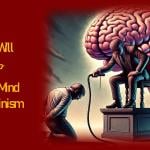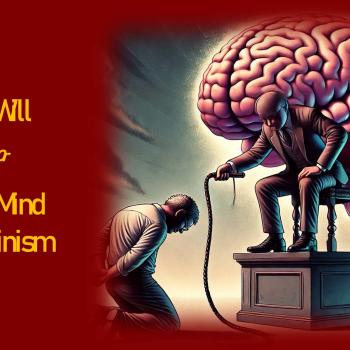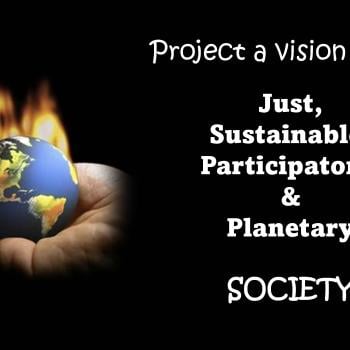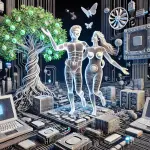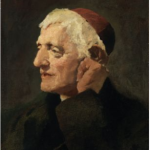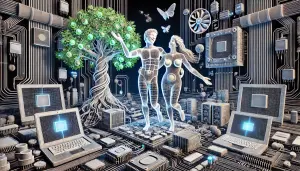
Is AI in the Image of God? This question was asked in a recent issue of Christianity Today. The article wrestles with the future of Artificial Intelligence and how it should be treated by Jesus’ disciples. In his thoughtful piece, “When we make intelligence in our image,” Timothy Dalrymple asks whether strong AI or AGI (Artificial General Intelligence) might eventually image of God (imago Dei) status.
But Dalrymple stops short of inviting AI into the imago Dei club. Dalrymple is willing to grant AI membership into a club with other intelligences, to be sure. But that’s our club. That’s the human club which has been commissioned by God to become technologically creative.
“We should be careful not to anthropomorphize or idolize artificial intelligence. Instead, we should welcome it for what it is—a reflection of God’s creativity in us that can lead to both extraordinary destruction and extraordinary good. And we should get about the business of making sure it’s the latter.”
Let’s re-ask the basic question: could AI in its strong form where it mimics human intelligence rightly claim to possess the image of God? To pose this question, we might have to remind ourselves of what Scripture and systematic theologians interpreting Scripture have to say on this topic.
Remind me, what is the image of God again?
In Genesis 2:7, God breathes into Adam’s nostrils so that we human persons share the breath of God, so to speak. In Genesis 1:26-29, male and female together share the imago Dei, which includes dominion within the creation. In 2 Corinthians 4:4, we find a significant shift from Adam and Eve to Jesus the Christ, who becomes the true image of God. Such biblical passages provide a diving board for springing into the pool of theological interpretations of the imago Dei.
What’s in the pool of imago Dei models? Each model seems to find some aspect of our being that exhibits continuity between human existence and the divine nature.
First, the Logos or rational model of the image of God
The first and most prominent is the rational theory or Logos theory. God is intelligent. So are we. Do we share God’s capacity for reasoning and rendering sound judgments based upon reason? The Logos of John 1 connects us to God, said Athanasius, John of Damascus, Augustine, and Vladimir Soloviev. They define the human being as a rational animal (zoon logikon, animal rationale) and then posit that our rational capacity corresponds to or participates in the divine mind. If intelligence and the capacity to reason define the imago Dei, then a future AGI robot could stand up and demand entrance into the imago Dei club.
Second, the moral model of the image of God
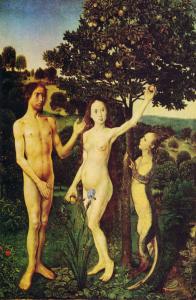 But the Logos model is not the only interpretation of what Scripture says. A second model substitutes morality for intelligence. Methodist hero John Wesley, for example, says that humans were created in God’s “natural image,” meaning that we are spiritual beings with free will, and that we were created in God’s “political image,” meaning that we share in the governance over nature. But most importantly we were created in God’s “moral image.” Prior to the fall we humans were filled with love, justice, mercy, and truth. When we first came from the hand of our creator we were pure and spotless. “God is love,” and we, created originally in God’s moral image, were also loving. We “knew not evil in any kind or degree.”
But the Logos model is not the only interpretation of what Scripture says. A second model substitutes morality for intelligence. Methodist hero John Wesley, for example, says that humans were created in God’s “natural image,” meaning that we are spiritual beings with free will, and that we were created in God’s “political image,” meaning that we share in the governance over nature. But most importantly we were created in God’s “moral image.” Prior to the fall we humans were filled with love, justice, mercy, and truth. When we first came from the hand of our creator we were pure and spotless. “God is love,” and we, created originally in God’s moral image, were also loving. We “knew not evil in any kind or degree.”
Frankly, I fear this moral model might not fly theologically. If it relies on a pre-lapsarian innocence of Adam and Eve, this implies ignorance of the difference between good and evil. It is the serpent, not God, who becomes responsible for the knowledge of good and evil. According to the moral model, Adam and Eve would be made in the image of the serpent, not God. Genesis and Wesley assume that the divine image was present in us prior to the fall. The moral model fails to pass the coherence test.
Despite this caveat, let’s draw out some implications of the moral model. Theologians roundly agree that AI, like all technologies, is morally ambiguous. It can be used by its human creators for good or evil. Anticipaing this, OpenAI founder Sam Altman formulated a mission statement regarding the future of AGI. “Our mission is to ensure that artificial general intelligence—AI systems that are generally smarter than humans—benefits all of humanity.” This should please Dalrymple, because it admonishes those of us created in God’s image to behave in a godly fashion.
Third, the relational model of the image of God
Third, a cluster of imago Dei theories emphasizes a shared dynamism between the human and divine life—that is, some sort of relationality. Karl Barth, for example, interprets the imago Dei passage of Genesis 1:26-29 to mean that we humans exist in relationship, that we have the capacity for an I-Thou encounter. This reflects the divine reality because relationality is internal to the Trinity. Claremont process theologian Marjorie Hewitt Suchocki, drawing upon Whiteheadian metaphysics, sees God as internally related to the world at every point. The late Notre Dame theologian Catherine Mowry LaCugna holds that the three persons of the Trinity relate to one another through the world. The point is that God’s relationality makes human relationality possible. The imago Dei is not then a quality that we humans possess by ourselves. Rather, it is an ongoing interaction between God and the human project. Jürgen Moltmann of Tübingen extends this a bit by saying that the imago Dei is a democratic society. It consists of human beings in relationship to one another—economically, socially, politically, and personally—and in relationship to the earth. God is relational and social. So are we.
Fourth, the proleptic model of the image of God
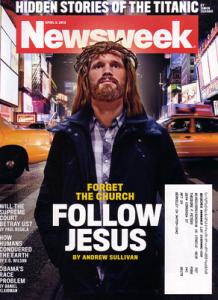 Our fourth is the proleptic model. The proleptic model begins with Jesus Christ, not Adam and Eve. That human integrity is already embodied in Christ and will attain its full splendor in the eschaton is key here. The proleptic model I am developing here seeks the imago Dei not in the old adam but in the new adam, not in the old creation but in the new one.
Our fourth is the proleptic model. The proleptic model begins with Jesus Christ, not Adam and Eve. That human integrity is already embodied in Christ and will attain its full splendor in the eschaton is key here. The proleptic model I am developing here seeks the imago Dei not in the old adam but in the new adam, not in the old creation but in the new one.
With obvious excitement Paul can proclaim “the gospel of the glory of Christ, who is the image of God” (εἰкών τò θεοû; 2 Cor. 4:4b). The term εἰкών (icon) is used both of Christ and of the person who has faith in Christ, and Paul describes us as “being transformed into the same image” (2 Cor. 3:18; see Rom. 8:29). The Christ of whom he speaks is the Easter Christ, the risen Christ, the first fruits of those having fallen asleep (1 Cor. 15:20, 48), the advent of the new creation. Christ as the divine image is our prototype. We live now as the imago Dei insofar as we live in him, insofar as we participate in the reality of the resurrection.
Fifth, the created co-creator model of the image of God
The fifth model is creativity. It is our creative propensity that demonstrates the image of God at work in the human phenomenon. The late Philip Hefner describes the human being as a “created co-creator.” What makes us co-creators with God is our self-awareness combined with our ability to make assessments in light of values and purposes, criticize those assessments, make decisions, and then act on those decisions. We can conceive of actions and then carry them out. We are homo faber. We make things; and the ability to make things compounds from generation to generation, so that the products of our creative design carry us farther and farther into a technological world we have created and into more complex relationships with the natural environment. Creativity and its resultant culture constitute an expression of our freedom.
But at the same time, this freedom to create does not make us independent. As Homo sapiens we are as dependent upon the health of the ecosystem as are all other forms of life. We constantly interact with it. No matter how masterful we judge the products of our creative hand, we have but transformed the basic resources that we found around us. We create nothing de novo, nothing that is totally new. Creatio ex nihilo is still solely God’s province.
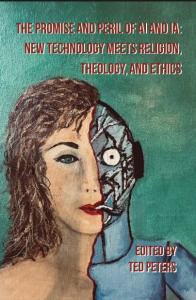
Conclusion
It appears to me that Timothy Dalrymple relies on models one and five, on the Logos plus the created co-creator. The product of human creativity – future strong AI or AGI – will be our creation in our image. Not God’s image. Our image. Then, like God, it will be our human responsibility to keep future AI oriented toward what is good rather than what is evil.
I see no reason to postulate that strong AI or AGI or even ASI (Artificial Super-Intelligence) would fit the proleptic model. Nothing in intelligence theory discussed among our data scientists remotely approximates the godliness that the image of God in Christ requires.
As of now. What about the future? When we meet an AGI bot or ASI bot, we will have to ask: are you in the image of God?
Patheos H+ 2013: Is AI in the Image of God?
Here are some other entries in our series, Adventures in Artificial Intelligence and Faith.
Patheos H+ 2006: Creating an AI Co-Creator? Philip Hefner’s Mind
Patheos H+ 2007: Hopes and Hazards of AI
Substack H+ 2008: The Two Scares of Superintelligence
Substack H+ 2010: Christianity in the Age of AI
Substack H+ 2011: Will AI Develop Selfhood and Disobedience?
Substack H+ 1027 H+ 2012 TESCREAL. TESCREAL, Transhumanism, and Cybertheology
Patheos H+ 2013: Is AI in the Image of God?
Substack H+ 2014: AI robots on the church pew? Prayer mat? Pulpit? Really? The future of AI in Cyber Religion
▓
Meet Ted Peters. For Patheos, Ted Peters posts articles and notices in the field of Public Theology. He is a Lutheran pastor and emeritus professor at the Graduate Theological Union. His single volume systematic theology, God—The World’s Future, is now in the 3rd edition. He has also authored God as Trinity plus Sin: Radical Evil in Soul and Society as well as Sin Boldly: Justifying Faith for Fragile and Broken Souls. In 2023 he published. The Voice of Public Theology, with ATF Press. This year he has published an edited volume, Promise and Peril of AI and IA: New Technology Meets Religion, Theology, and Ethics (ATF) and along with Arvin Gouw an edited collection, The CRISPR Revolution in Science, Religion, and Ethics (Bloomsbury 2025). See his website: TedsTimelyTake.com and Substack blog site on the Voice of Public Theology Newsletter.
▓



